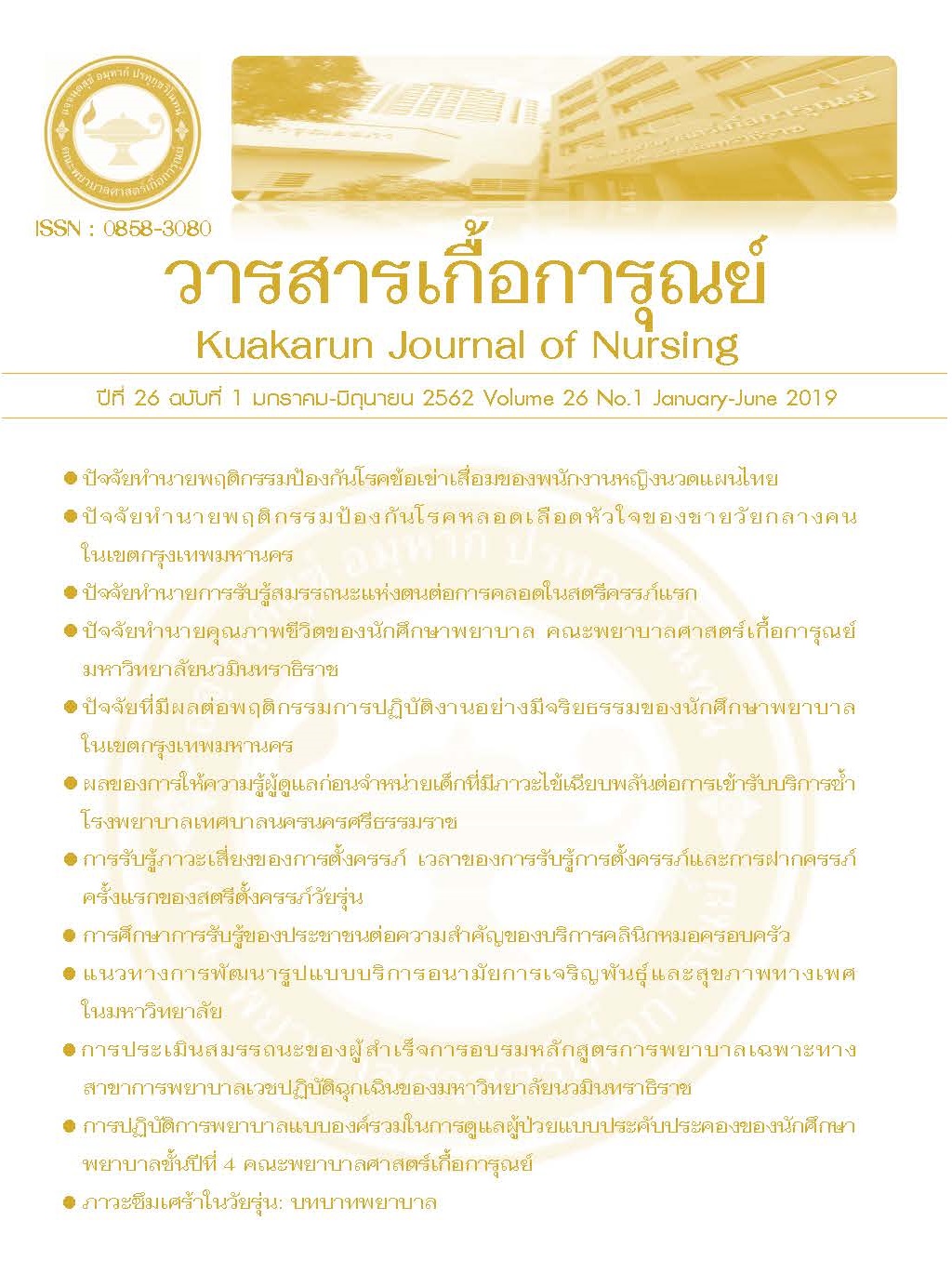ผลของการให้ความรู้ผู้ดูแลก่อนจำหน่ายเด็กที่มีภาวะไข้เฉียบพลันต่อการเข้ารับบริการซ้ำ โรงพยาบาลเทศบาลนครนครศรีธรรมราช
คำสำคัญ:
การให้ความรู้ก่อนจำหน่าย, ภาวะไข้เฉียบพลันในเด็ก, การรับบริการซ้ำบทคัดย่อ
ภาวะไข้เฉียบพลันในเด็กเป็นอาการทางคลินิกที่พบบ่อย ความรู้ของผู้ดูแลเด็กที่มีภาวะนี้ จึงมีความสำคัญ การวิจัยกึ่งทดลองนี้มีวัตถุประสงค์เพื่อศึกษาผลของการให้ความรู้ผู้ดูแลก่อนจำหน่ายเด็กที่มีภาวะไข้เฉียบพลันต่อการรับบริการซ้ำโรงพยาบาลเทศบาลนครนครศรีธรรมราช กลุ่มตัวอย่างเป็นผู้ดูแลเด็กอายุ 3 เดือนถึง 5 ปีที่มีภาวะไข้เฉียบพลันใน 24 ชั่วโมงแรก เข้ารับบริการที่แผนกอุบัติเหตุฉุกเฉิน ใช้การสุ่มอย่างง่ายโดยให้วันคู่เป็นกลุ่มทดลองและวันคี่เป็นกลุ่มควบคุม กลุ่มละ 38 ราย กลุ่มทดลองได้รับ (1) การให้ความรู้ (2) ทักษะ การจัดการภาวะไข้และ (3) การติดตามทางโทรศัพท์ 2 ครั้ง กลุ่มควบคุมได้รับการพยาบาลตามปกติ ดำเนินการเก็บข้อมูลเดือนพฤษภาคมถึงกรกฎาคม พ.ศ. 2560 ประเมินผลด้วยแบบประเมินความรู้ในการจัดการภาวะไข้ของผู้ดูแล และแบบสัมภาษณ์จำนวนครั้งของการรับบริการด้วยภาวะไข้เฉียบพลันใน 72 ชั่วโมง วิเคราะห์ข้อมูลด้วยสถิติเชิงพรรณนาและใช้สถิติ t-test, Chi-square และ Fisher’s exact test
ผลการวิจัย พบว่า ผู้ดูแลกลุ่มทดลองมีความรู้ในการจัดการภาวะไข้ของเด็กที่บ้านดีขึ้นมากกว่ากลุ่มควบคุมอย่างมีนัยสำคัญทางสถิติ (p <0.05) เมื่อทำการให้ความรู้และติดตามต่อเนื่องทางโทรศัพท์ พบว่า ผู้ดูแลมีความรู้และสามารถปฏิบัติทักษะในการจัดการภาวะไข้ได้อย่างมีความมั่นใจมากขึ้น ส่งผลให้ผู้ดูแลกลุ่มทดลอง (ร้อยละ 15.80) นำเด็กกลับเข้ารับบริการซ้ำภายใน 72 ชั่วโมงน้อยกว่ากลุ่มควบคุม (ร้อยละ 39.50) อย่างมีนัยสำคัญทางสถิติที่ระดับ 0.05 ข้อเสนอแนะ พยาบาลแผนกอุบัติเหตุ-ฉุกเฉิน ควรให้ความสำคัญกับการให้ความรู้แก่ผู้ดูแล ก่อนที่จะจำหน่ายเด็กที่มีภาวะไข้เฉียบพลันกลับบ้านจากแผนกอุบัติเหตุฉุกเฉินร่วมกับการติดตามต่อเนื่องทางโทรศัพท์เพื่อกระตุ้นเตือนความรู้อย่างต่อเนื่องของผู้ดูแลหลังจำหน่าย เพิ่มความมั่นใจให้ผู้ดูแลสามารถดูแลจัดการภาวะไข้และประเมินอาการของเด็กได้เองที่บ้านอย่างปลอดภัย
เอกสารอ้างอิง
วัลลภา วาสนาสมปอง, ธนวัฒน์ ชัยพงษ์พัชรา, วันวิสาข์ สายสนั่น ณ อยุธยา, พงษ์มาดา ดามาพงศ์,สุรีวรรณ สีลาดเลา และ ธรรมศักดิ์ สายแก้ว. (2557). ผลของโปรแกรมสุขศึกษาโดยประยุกต์ทฤษฎีแบบแผนความเชื่อด้านสุขภาพเพื่อป้องกัน โรคไข้หวัดของนักเรียนระดับชั้นประถมศึกษาปีที่ 5.การประชุมวิชาการและนำเสนอผลงานวิจัย ระดับชาติ และนานาชาติ ด้านการศึกษา ครั้งที่ 6, 3(6), 397-409. กรุงเทพฯ.
ศุภิศา ลี้มิ่งสวัสดิ์. (2555). ปัจจัยที่มีความสัมพันธ์กับการจัดการของบิดามารดาเมื่อเด็กมีภาวะไข้. (วิทยานิพนธ์ปริญญามหาบัณฑิต, มหาวิทยาลัยบูรพา).
สมจิตร จารรุรัตนศิริกุล, กมลวิช เลาประสพวัฒนา, มณีรัตน์ ภูวนนท์ และ นครินทร์ ตนคลัง. (2555). กุมารเวชศาสตร์ผู้ป่วยนอก. สงขลา: ชานเมืองการพิมพ์.
สำนักระบาดวิทยา กรมควบคุมโรค. (2559). สรุปรายงานการเฝ้าระวังโรคประจำปี 2559. กรุงเทพฯ: กรมควบคุมโรค กระทรวงสาธารณสุข.
สุธิศา ล่ามช้าง, อมรรัชช์ งามสวย, อรพิน จันทร์ปัญญาสกุล และ ปรีชา ล่ามช้าง. (2560). ความวิตก กังวล การสื่อสารระหว่างผู้ดูแลและพยาบาล และการปฏิบัติป้องกันอาการชักจากไข้ของผู้ดูแล เด็กป่วยเฉียบพลัน. พยาบาลสาร, 44(1), 74-85.
สุธีรา เอื้อไพโรจน์กิจ. (2558).ป้องกัน 25 โรคฮิตให้ลูกรัก.กรุงเทพฯ: ซีเอ็ดยูเคชั่น.
หน่วยรายงานสถิติทางการแพทย์ งานเวชระเบียนและสถิติ โรงพยาบาลเทศบาลนครนครศรีธรรมราช. (2559). สถิติโรคปี 2559. นครศรีธรรมราช: กองการแพทย์ เทศบาลนครนครศรีธรรมราช.
อุดมลักษณ์ เพียรสุขเวช และ พรรณี บัญชรหัตถกิจ. (2557). ผลของโปรแกรมสุขศึกษาในการป้องกันโรคมือเท้าปากในวัยเด็กโดยการประยุกต์แบบแผนความเชื่อด้านสุขภาพและแรงสนับสนุนทางสังคมของผู้ดูแลเด็กและผู้ปกครองเด็กในศูนย์พัฒนาเด็กเล็ก อำเภอเมือง จังหวัดขอนแก่น. ศรีนครินทร์เวชสาร, 29(2), 158-163.
Beck, A. T. (1985).Theoretical perspectives on clinical anxiety. In A.H. Tuma& J.D. Maser (Eds.), Anxiety and the anxiety disorders (pp. 183–196). Hillsdale, NJ: Erlbaum.
Children’s Health Queensland Hospital and Health Service.Fever in children.Retrieved from https://www.childrens.health.qld.gov.au/fact-sheet-fever- in-children/
Considine, J. & Brennan, D. (2007).Effect of an evidence-based education programme on ED discharge advice for febrile children. Journal of Clinical Nursing, 16(9), 1687-1694.
El-Radhi, A. S. (2012). Fever management: Evidence vs current practice. World Journal of Clinical Pediatrics, 8(4), 29-33.
Goldman, R. D., Ong, M. & Macpherson, A. (2006). Unscheduled return visit to the pediatric emergency department-one-year experience. Pediatric Emergency Care, 22(8), 545-549.
Graneto, J. W. (2016). Emergent management of pediatric patients with fever. Retrieved from https://emedicine.medscape.com/article/801598-overview
Hansen, E. H. &Hunskaar, S. (2011). Understanding of and adherence to advice after telephone counselling by nurse: A survey among callers to a primary emergency out-of-hours service in Norway.BioMed Central (BMC), 2011, 1-8.
Katz, S. R., Rowberry, J., Ho M. (2009).Fever determination in young infants: Prevalence and accuracy of parental palpation. PediatrEmerg Care.25(1).12–14.
McDougall, P. & Harrison, M. (2014). Fever and feverish illness in children under five years. Nursing Standard / RCN Publishing, 28(30), 49-59.
Purssell, E. & Collin, J. (2015). Review: Fever phobia: The impact of time and mortality- A systematic review and meta-analysis. International Journal of Nursing Studies, 9, 1-9
Purssell, E. (2013). Antipyretic use in children: More than just temperature. Journal Pediator (Rio J), 89(1), 1−3
Royal College of Nursing. (2015). Caring for children with fever: RCN good practice guidance for nurse working with infants, children and young people. London, England: Royal College of Nursing.
Sabine, W., Katharine, A., &Steketee, G. (2013). Cognitive-Behavioral Therapy for body dysmorphic disorder: A treatment manual. NY, Guilford Press, 245-324.
The Children’s Hospital of Eastern Ontario.(2016). Fever. Retrieved from https://www.cheo.on.ca/ uploads/Fever/Fever.pdf
Tri N Susilawati, Mcbride, W. J. (2014). Acute undifferentiated fever in Asia: A review of the literature. The Southeast Asian Journal of Tropical Medicine and Public Health, 45(3), 719-726.
Walsh, A., Edwards, H. & Fraser, J. (2007). Influences on parents' fever management: Beliefs, experiences and information sources. Journal of Clinical Nursing, 12, 2331-2340.
Zomorrodi, A. &Attia, M. W. (2008). Fever: Parental concerns. Clinical Pediatric Emergency Medicine, 9, 238-243.















